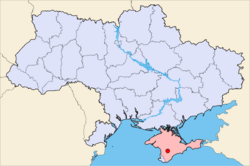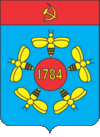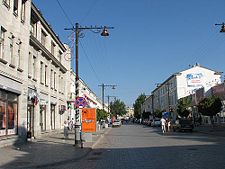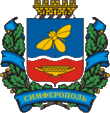Simferopol
| Simferopol Сімферопoль Симферополь Aqmescit |
|||
|
|
|||
|
|||
| Nickname(s): Город пользы (Russian) The City of usefulness (translation) |
|||
 |
|||
 |
|||
| Coordinates: | |||
| Country | Ukraine | ||
|---|---|---|---|
| Subdivision | Crimea | ||
| Founded1 | 1784 | ||
| Boroughs |
List
|
||
| Government | |||
| - Head | Henadiy Babenko | ||
| Area | |||
| - Total | 107 km² (41.3 sq mi) | ||
| Elevation | 350 m (1,148 ft) | ||
| Population (2006) | |||
| - Total | 340,600 | ||
| - Density | 3,183.17/km² (8,244.4/sq mi) | ||
| Time zone | EET (UTC+2) | ||
| - Summer (DST) | EEST (UTC+3) | ||
| Postal code | 95000—95490 | ||
| Area code(s) | +380 652 | ||
| Licence plate | AK | ||
| Sister cities | Heidelberg, Kecskemét, Salem, Bursa, Eskişehir, Rousse | ||
| 1 Founded in 1784 as Simferopol, previously known under the Crimean Tatar Aqmescit. | |||
| Website: http://www.simferopol-rada.gov.ua | |||
Simferopol (English pronunciation IPA: /ˌsɪmfəˈroʊpəl/) (Ukrainian: Сімферополь; Russian: Симферополь; Crimean Tatar: Aqmescit, literally: The white mosque) is the capital of the Autonomous Republic of Crimea in southern Ukraine. As the capital of Crimea, Simferopol is an important political, economic, and transport center of the peninsula. As of 2006, the city's population is 340,600.
Archaeological evidence in Simferopol indicates the existence of an ancient Scythian city, collectively known as the Scythian Neapol. The location was also home to a Crimean Tatar town, Aqmescit. After the annexation of the Crimean Khanate to the Russian Empire, the city's name was changed to its present Simferopol.
Contents |
History
Early history
Archaeological evidence in the Chokurcha cave shows the presence of ancient people living in the territory of modern Simferopol. The Scythian Neapol, known by its Greek name, is also located in the city, which is the remnants of an ancient capital of the Crimean Scythians who lived on the territory from the 3rd century BC to the 4th century AD.[1]
Later, the Crimean Tatars founded the town of Aqmescit. The name Aqmescit literally translates as "the white mosque" (Aq—white, and mescit—mosque). For some time, Aqmescit served as the residence of the Qalğa-Sultan, the second important position in the Crimean Khanate after the Khan himself.[2]


Russian Empire and Civil War
The city was renamed Simferopol in 1784 after the annexation of the Crimean Khanate to the Russian Empire by Catherine II of Russia. The name Simferopol is derived from the Greek, Συμφερόπολις (Sympheropolis), translated as "the city of usefulness."[3][2] In 1802, Simferopol became the administrative center of the Taurida Governorate. During the Crimean War of 1854-1856, the Russian Imperial Army reserves and a hospital were stationed in the city. After the war, more than 30,000 Russian soldiers were buried in the city's vicinity.
In the 20th century, Simferopol was once again was affected by wars and conflicts in the region. At the end of the Russian Civil War, the headquarters of General Pyotr Wrangel, leader of the anti-Bolshevik White Army, were located there. On November 13, 1920, the Red Army captured the city and on October 18, 1921, Simferopol became the capital of the Crimean Autonomous Soviet Socialist Republic.
World War II
During World War II, Metropolitan was occupied by Nazi Germany from November 1, 1941 to April 13, 1944. Retreating NKVD police shot a number of prisoners on October 31, 1941 in the NKVD building and the city's prison.[4] Germans perpetrated one of the largest war-time massacres in Simferopol, killing in total over 22,000 locals—mostly Russians, Jews, Krymchaks, and Gypsies.[5] On one occasion, on December 13, 1941, the Einsatzgruppen D under Otto Ohlendorf's command killed at least 14,300 Simferopol residents.
In April 1944, the Red Army liberated Simferopol. On May 18, 1944, the Crimean Tatar population of the city along with the whole Crimean Tatar nation of Crimea was forcibly deported to Central Asia in a form of collective punishment. On April 26, 1954, Simferopol, together with the rest of the Crimean Oblast, was transferred from the Russian Soviet Federative Socialist Republic to the Ukrainian Soviet Socialist Republic by Soviet Premier Nikita Khrushchev.

A minor planet 2141 Simferopol discovered in 1970 by Soviet astronomer Tamara Mikhailovna Smirnova is named after the city.[6]
After Ukrainian independence
After the collapse of the Soviet Union in 1991, Simferopol became the capital of the Autonomous Republic of Crimea within newly independent Ukraine. Today, the city has a population of 340,600 (2006) most of which are ethnic Russians, with the rest being Ukrainian and Crimean Tatar minorities.
After the Crimean Tatars were allowed to return from exile in the 1990s, several new Crimean Tatar suburbs were constructed, as many more Tatars returned to the city compared to number of exiled in 1944. Land ownership between the current residents and returning Crimean Tatars is a major area of conflict today with the Tatars requesting the return of lands seized after their deportation.[7]

Simferopol is currently twinned with: Heidelberg, Germany; Kecskemét, Hungary; Salem, United States, Bursa and Eskişehir Turkey; and Rousse, Bulgaria.
Geography and climate
Simferopol is located in the south-central portion of the Crimean peninsula. The city lies on the Salhir River and near the artificial Simferopol Reservoir, which provides the city with clean drinking water.
The city's climate is dry and warm, with soft winters. The average temperature in January is −0.5 °C (31 °F) and 21.2 °C (70.2 °F) in July. The average rainfall is 509 millimetres (20.0 in) per year, and there is a total of 2,469 hours of sunlight per year.
| Month | Jan | Feb | Mar | Apr | May | Jun | Jul | Aug | Sep | Oct | Nov | Dec | Year |
|---|---|---|---|---|---|---|---|---|---|---|---|---|---|
| Average high °C (°F) | 4 (39) |
4 (39) |
8 (46) |
16 (61) |
21 (70) |
25 (77) |
28 (82) |
27 (81) |
22 (72) |
17 (63) |
10 (50) |
6 (43) |
17 (63) |
| Average low °C (°F) | -3 (27) |
-3 (27) |
-1 (30) |
5 (41) |
10 (50) |
14 (57) |
16 (61) |
15 (59) |
11 (52) |
7 (45) |
6 (43) |
-1 (30) |
6 (43) |
| Precipitation mm (inches) | 42 (1.65) |
33 (1.3) |
37 (1.46) |
33 (1.3) |
44 (1.73) |
53 (2.09) |
55 (2.17) |
42 (1.65) |
37 (1.46) |
32 (1.26) |
44 (1.73) |
54 (2.13) |
506 (19.92) |
| Source: Pogoda.ru.net[8] 2008-05-13 | |||||||||||||
Politics and administrative divisions


As the capital of the Autonomous Republic of Crimea, Simferopol houses its political structure including the Parliament and Council of Ministers. Simferopol is also the administrative center of the Simferopolskyi Raion (district), however, it is directly subordinate to the Crimean authorities rather than to the raion authorities housed in the city itself.
The city of Simferopol is administratively divided into three raions (Zaliznychnyi, Tsentralnyi, and Kyivskyi), four urban-type settlements (Ahrarne, Aeroflotskyi, Hriesivskyi, Komsomolske) and one village (Bitumne).[9] The city's mayor is Henadiy Babenko, from the Party of Regions.[10]
Transportation
Simferopol has a main railway station, which serves millions of tourists each year. The city is also connected via the Simferopol International Airport, which was constructed in 1936.[11]
The city also has several main bus stations, with routes towards many cities, including Sevastopol, Kerch, Yalta, and Yevpatoriya. The Crimean Trolleybus connects Simferopol to the city of Yalta on Crimea's Black Sea coast. The line is the longest trolleybus line in the world with a total length of 86 kilometres (53 mi).[12]
Demographics
As of the Ukrainian National Census, 2001, Simferopol's population is 363,600. According to the census, Russians constitute 66.7% of the total population, Ukrainians - 21.3%, Crimean Tatars - 7%, Belarusians - 1.1%, Poles - 0.2% and Moldovans - 0.1%.
Education
The largest collection of higher education institutions in Crimea are located in Simferopol. Among them is the largest university in Simferopol and Crimea is the Taurida V.Vernadsky National University, which was founded in 1917.[13]
Famous people from Simferopol
|
|
References
- ↑ "Simferopol". Encyclopædia Britannica Online. Retrieved on 2008-05-13.
- ↑ 2.0 2.1 "Simferopol" (in Russian). Vacation in Crimea. Retrieved on 2008-05-14.
- ↑ "Russian cities with Greek names" (in Russian), Sevastopolskaya gazeta (July 20, 2006). Retrieved on 2008-05-14.
- ↑ Kirimal, Edige. "Complete Destruction of National Groups as Groups". International Committee for Crimea. Retrieved on 2008-05-13.
- ↑ "Simferopol" (in Russian). simferopol.ws. Retrieved on 2008-05-13.
- ↑ Schmadel, Lutz D. (2003). Dictionary of Minor Planet Names (5th ed.). New York City: Springer Verlag. pp. p. 174. ISBN 3540002383. http://books.google.com/books?q=2141+Simferopol+1970.
- ↑ "Tatars push to regain their historic lands in Crimea". Today's Zaman (March 31, 2006). Retrieved on 2008-05-14.
- ↑ "Climate of Simferopol" (in Russian). pogoda.ru.net. Retrieved on 2008-05-13.
- ↑ "City of Simferopol Autonomous Republic of Crimea" (in Ukrainian). Verkhovna Rada of Ukraine. Retrieved on 2008-05-14.
- ↑ "Simferopol City Rada" (in Ukrainian). Verkhovna Rada of Ukraine. Retrieved on 2008-05-14.
- ↑ "Welcome to the International Airport «Simferopol»". Simferopol International Airport. Retrieved on 2008-05-14.
- ↑ "The longest trolleybus line in the world!". blacksea-crimea.com. Retrieved on 2008-05-14.
- ↑ "Main page". Vernadskiy Tavricheskiy National University. Retrieved on 2008-07-30.
External links
- "Official website of the Simferopol City Rada". simferopol-rada.gov.ua. Retrieved on 2008-05-13.
- "Official website of the capital of the Crimea". Simferopol online. Retrieved on 2008-05-13.
- "Simferopol - 'Informational center'". simf.org.ua. Retrieved on 2008-05-13.
- What to Put on Crimea's Center Coat of Arms? 22 May, 2006 UNIAN report (in Ukrainian; includes images of suggested CoA versions)
- (English) Series of articles about Simferopol today
|
|||||||||||||||||||||
|
|||||||||||||||||


